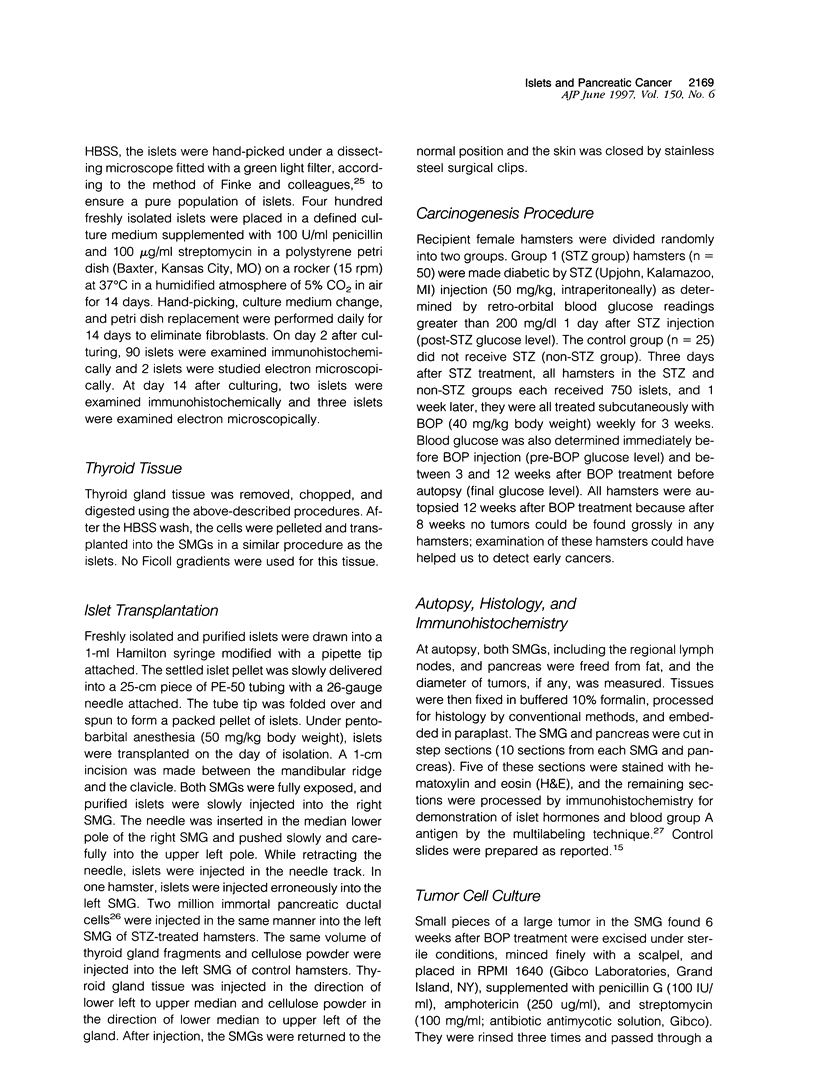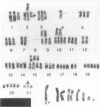Abstract
To investigate the role of the islets of Langerhans in pancreatic carcinogenesis, freshly isolated islets from male Syrian hamsters were transplanted into the right submandibular glands of 50 female hamsters that were or were not pre-treated with streptozotocin. Thyroid gland fragments, cellulose powder, and immortal hamster pancreatic ductal cells were injected into the left submandibular gland of the same hamsters. All recipient hamsters were then treated with the potent pancreatic carcinogen N-nitrosobis(2-oxopropyl)amine weekly at a dose of 40 mg/kg of body weight for 3 weeks. Between 3 and 8 weeks later, 18 of 75 (24%) hamsters developed large ductal-type adenocarcinomas in the submandibular gland region, where islets were transplanted, but none developed tumors in the left submandibular gland. In 9 of 18 hamsters, tumors were multiple so that a total of 31 cancers were found. Eleven of these carcinomas were in the vicinity of transplanted islets, eight of which showed intra-insular ductular or cyst formation as seen in the pancreas of hamsters during pancreatic carcinogenesis. The formation of ductular structures within islets was also demonstrated in vitro. Some tumor cells in the vicinity of these islets were reactive with anti-insulin. Y chromosome message was found by polymerase chain reaction analysis in one of the three tumors examined. Also, like the induced pancreatic tumors, all three submandibular gland tumors that were examined had the mutation of the c-Ki-ras oncogene at codon 12 and all tumors expressed blood group A antigen. These and other findings strongly suggest that some components of islets, most probably stem cells, are the origin of ductal-type adenocarcinomas in this model.
Full text
PDF













Images in this article
Selected References
These references are in PubMed. This may not be the complete list of references from this article.
- Albert J., Fenyö E. M. Simple, sensitive, and specific detection of human immunodeficiency virus type 1 in clinical specimens by polymerase chain reaction with nested primers. J Clin Microbiol. 1990 Jul;28(7):1560–1564. doi: 10.1128/jcm.28.7.1560-1564.1990. [DOI] [PMC free article] [PubMed] [Google Scholar]
- Bardi G., Johansson B., Pandis N., Mandahl N., Bak-Jensen E., Andrén-Sandberg A., Mitelman F., Heim S. Karyotypic abnormalities in tumours of the pancreas. Br J Cancer. 1993 May;67(5):1106–1112. doi: 10.1038/bjc.1993.203. [DOI] [PMC free article] [PubMed] [Google Scholar]
- Bell R. H., Jr, Pour P. M. Pancreatic carcinogenicity of N-nitrosobis(2-oxopropyl)-amine in diabetic and non-diabetic Chinese hamsters. Cancer Lett. 1987 Feb;34(2):221–230. doi: 10.1016/0304-3835(87)90014-0. [DOI] [PubMed] [Google Scholar]
- Bell R. H., Jr, Sayers H. J., Pour P. M., Ray M. B., McCullough P. J. Importance of diabetes in inhibition of pancreatic cancer by streptozotocin. J Surg Res. 1989 May;46(5):515–519. doi: 10.1016/0022-4804(89)90170-4. [DOI] [PubMed] [Google Scholar]
- Bockman D. E. Cells of origin of pancreatic cancer: experimental animal tumors related to human pancreas. Cancer. 1981 Mar 15;47(6 Suppl):1528–1534. doi: 10.1002/1097-0142(19810315)47:6+<1528::aid-cncr2820471415>3.0.co;2-x. [DOI] [PubMed] [Google Scholar]
- Brockenbrough J. S., Weir G. C., Bonner-Weir S. Discordance of exocrine and endocrine growth after 90% pancreatectomy in rats. Diabetes. 1988 Feb;37(2):232–236. doi: 10.2337/diab.37.2.232. [DOI] [PubMed] [Google Scholar]
- Chick W. L. Beta cell replication in rat pancreatic monolayer cultures. Effects of glucose, tolbutamide, glucocorticoid, growth hormone and glucagon. Diabetes. 1973 Sep;22(9):687–693. doi: 10.2337/diab.22.9.687. [DOI] [PubMed] [Google Scholar]
- Egami H., Chaney W. G., Takiyama Y., Pour P. M. Subcellular localization of blood group A substance produced by pancreatic adenocarcinoma induced in hamsters by N-nitrosobis(2-oxopropyl)amine (BOP) and by its cell line (PC-1). Carcinogenesis. 1991 Mar;12(3):509–514. doi: 10.1093/carcin/12.3.509. [DOI] [PubMed] [Google Scholar]
- Flaks B., Moore M. A., Flaks A. Ultrastructural analysis of pancreatic carcinogenesis. V. Changes in differentiation of acinar cells during chronic treatment with N-nitrosobis(2-hydroxypropyl)amine. Carcinogenesis. 1982;3(5):485–498. doi: 10.1093/carcin/3.5.485. [DOI] [PubMed] [Google Scholar]
- Fujii H., Egami H., Chaney W., Pour P., Pelling J. Pancreatic ductal adenocarcinomas induced in Syrian hamsters by N-nitrosobis(2-oxopropyl)amine contain a c-Ki-ras oncogene with a point-mutated codon 12. Mol Carcinog. 1990;3(5):296–301. doi: 10.1002/mc.2940030510. [DOI] [PubMed] [Google Scholar]
- Gubbay J., Collignon J., Koopman P., Capel B., Economou A., Münsterberg A., Vivian N., Goodfellow P., Lovell-Badge R. A gene mapping to the sex-determining region of the mouse Y chromosome is a member of a novel family of embryonically expressed genes. Nature. 1990 Jul 19;346(6281):245–250. doi: 10.1038/346245a0. [DOI] [PubMed] [Google Scholar]
- Ishikawa O., Ohigashi H., Imaoka S., Nakai I., Mitsuo M., Weide L., Pour P. M. The role of pancreatic islets in experimental pancreatic carcinogenicity. Am J Pathol. 1995 Nov;147(5):1456–1464. [PMC free article] [PubMed] [Google Scholar]
- Johansson B., Bardi G., Heim S., Mandahl N., Mertens F., Bak-Jensen E., Andrén-Sandberg A., Mitelman F. Nonrandom chromosomal rearrangements in pancreatic carcinomas. Cancer. 1992 Apr 1;69(7):1674–1681. doi: 10.1002/1097-0142(19920401)69:7<1674::aid-cncr2820690706>3.0.co;2-l. [DOI] [PubMed] [Google Scholar]
- Lacy P. E., Kostianovsky M. Method for the isolation of intact islets of Langerhans from the rat pancreas. Diabetes. 1967 Jan;16(1):35–39. doi: 10.2337/diab.16.1.35. [DOI] [PubMed] [Google Scholar]
- Logothetopoulos J., Valiquette N., Cvet D. Glucose stimulation of beta-cell DNA replication in the intact rat and in pancreatic islets in suspension culture. Effects of alpha-ketoisocaproic acid, dibutyryl cyclic AMP, and 3-isobutyl-1-methylxanthine in the in vitro system. Diabetes. 1983 Dec;32(12):1172–1176. doi: 10.2337/diab.32.12.1172. [DOI] [PubMed] [Google Scholar]
- Longnecker D. S. Carcinogenesis in the pancreas. Arch Pathol Lab Med. 1983 Feb;107(2):54–58. [PubMed] [Google Scholar]
- Longnecker D. S., Curphey T. J. Adenocarcinoma of the pancreas in azaserine-treated rats. Cancer Res. 1975 Aug;35(8):2249–2258. [PubMed] [Google Scholar]
- Longnecker D. S., Roebuck B. D., Kuhlmann E. T., Curphey T. J. Induction of pancreatic carcinomas in rats with N-nitroso(2-hydroxypropyl)(2-oxopropyl)amine: histopathology. J Natl Cancer Inst. 1985 Jan;74(1):209–217. [PubMed] [Google Scholar]
- Longnecker D. S., Shinozuka H., Dekker A. Focal acinar cell dysplasia in human pancreas. Cancer. 1980 Feb;45(3):534–540. doi: 10.1002/1097-0142(19800201)45:3<534::aid-cncr2820450320>3.0.co;2-g. [DOI] [PubMed] [Google Scholar]
- Permert J., Larsson J., Westermark G. T., Herrington M. K., Christmanson L., Pour P. M., Westermark P., Adrian T. E. Islet amyloid polypeptide in patients with pancreatic cancer and diabetes. N Engl J Med. 1994 Feb 3;330(5):313–318. doi: 10.1056/NEJM199402033300503. [DOI] [PubMed] [Google Scholar]
- Pour P. M., Bell R. H. Alteration of pancreatic endocrine cell patterns and their secretion during pancreatic carcinogenesis in the hamster model. Cancer Res. 1989 Nov 15;49(22):6396–6400. [PubMed] [Google Scholar]
- Pour P. M. Experimental pancreatic cancer. Am J Surg Pathol. 1989;13 (Suppl 1):96–103. [PubMed] [Google Scholar]
- Pour P. M. Histogenesis of exocrine pancreatic cancer in the hamster model. Environ Health Perspect. 1984 Jun;56:229–243. doi: 10.1289/ehp.8456229. [DOI] [PMC free article] [PubMed] [Google Scholar]
- Pour P. M., Kazakoff K., Carlson K. Inhibition of streptozotocin-induced islet cell tumors and N-nitrosobis(2-oxopropyl)amine-induced pancreatic exocrine tumors in Syrian hamsters by exogenous insulin. Cancer Res. 1990 Mar 1;50(5):1634–1639. [PubMed] [Google Scholar]
- Pour P. M., Kazakoff K., Dulaney K. A new multilabeling technique for simultaneous demonstration of different islet cells in permanent slides. Int J Pancreatol. 1993 Apr;13(2):139–142. doi: 10.1007/BF02786082. [DOI] [PubMed] [Google Scholar]
- Pour P. M., Kazakoff K. Stimulation of islet cell proliferation enhances pancreatic ductal carcinogenesis in the hamster model. Am J Pathol. 1996 Sep;149(3):1017–1025. [PMC free article] [PubMed] [Google Scholar]
- Pour P. M., Permert J., Mogaki M., Fujii H., Kazakoff K. Endocrine aspects of exocrine cancer of the pancreas. Their patterns and suggested biologic significance. Am J Clin Pathol. 1993 Sep;100(3):223–230. doi: 10.1093/ajcp/100.3.223. [DOI] [PubMed] [Google Scholar]
- Pour P. M., Weide L. G., Ueno K., Corra S., Kazakoff K. Submandibular gland as a site for islet transplantation. Int J Pancreatol. 1992 Oct;12(2):187–191. doi: 10.1007/BF02924644. [DOI] [PubMed] [Google Scholar]
- Pour P. Islet cells as a component of pancreatic ductal neoplasms. I. Experimental study: ductular cells, including islet cell precursors, as primary progenitor cells of tumors. Am J Pathol. 1978 Feb;90(2):295–316. [PMC free article] [PubMed] [Google Scholar]
- Sinclair A. H., Berta P., Palmer M. S., Hawkins J. R., Griffiths B. L., Smith M. J., Foster J. W., Frischauf A. M., Lovell-Badge R., Goodfellow P. N. A gene from the human sex-determining region encodes a protein with homology to a conserved DNA-binding motif. Nature. 1990 Jul 19;346(6281):240–244. doi: 10.1038/346240a0. [DOI] [PubMed] [Google Scholar]
- Smith L. M., Sanders J. Z., Kaiser R. J., Hughes P., Dodd C., Connell C. R., Heiner C., Kent S. B., Hood L. E. Fluorescence detection in automated DNA sequence analysis. Nature. 1986 Jun 12;321(6071):674–679. doi: 10.1038/321674a0. [DOI] [PubMed] [Google Scholar]
- Takahashi T., Moyer M. P., Cano M., Wang Q. J., Adrian T. E., Mountjoy C. P., Sanger W., Sugiura H., Katoh H., Pour P. M. Establishment and characterization of a new, spontaneously immortalized, pancreatic ductal cell line from the Syrian golden hamster. Cell Tissue Res. 1995 Oct;282(1):163–174. doi: 10.1007/BF00319143. [DOI] [PubMed] [Google Scholar]
- Takahashi T., Moyer M. P., Cano M., Wang Q. J., Mountjoy C. P., Sanger W., Adrian T. E., Sugiura H., Katoh H., Pour P. M. Differences in molecular biological, biological and growth characteristics between the immortal and malignant hamster pancreatic cells. Carcinogenesis. 1995 Apr;16(4):931–939. doi: 10.1093/carcin/16.4.931. [DOI] [PubMed] [Google Scholar]
- Takiyama Y., Egami H., Pour P. M. Expression of human tumor-associated antigens in pancreatic cancer induced in Syrian hamsters. Am J Pathol. 1990 Mar;136(3):707–715. [PMC free article] [PubMed] [Google Scholar]
- Tomioka T., Toshkov I., Kazakoff K., Andrén-Sandberg A., Takahashi T., Büchler M., Friess H., Vaughn R., Pour P. M. Cellular and subcellular localization of transforming growth factor-alpha and epidermal growth factor receptor in normal and diseased human and hamster pancreas. Teratog Carcinog Mutagen. 1995;15(5):231–250. doi: 10.1002/tcm.1770150503. [DOI] [PubMed] [Google Scholar]










